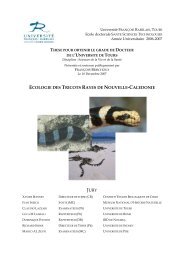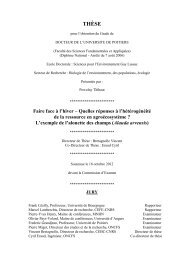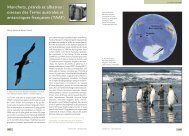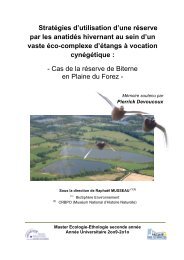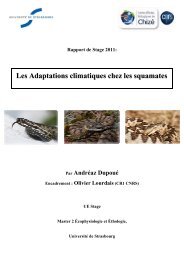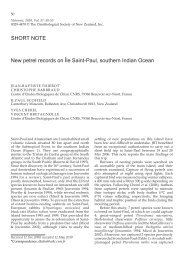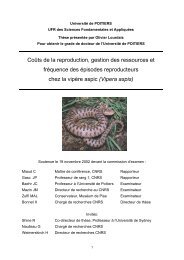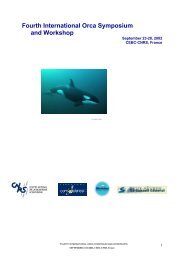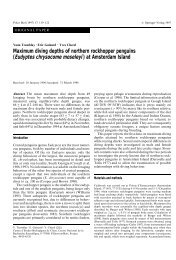Forçage environnemental et prédateurs marins ... - Cebc - CNRS
Forçage environnemental et prédateurs marins ... - Cebc - CNRS
Forçage environnemental et prédateurs marins ... - Cebc - CNRS
You also want an ePaper? Increase the reach of your titles
YUMPU automatically turns print PDFs into web optimized ePapers that Google loves.
Population dynamics in a marine top predator C. Barbraud and H. Weimerskirch 2113<br />
Table 1. Statistical capture–recapture models.<br />
(D i is the difference in QAICc b<strong>et</strong>ween the lowest QAICc model and QAICc of model i; wi the Akaike weights, and np the<br />
number of param<strong>et</strong>ers estimated by Mark. ¤ and 1 respectively denote models with and without interactions. ps(SSTA) indicates<br />
that summer recapture probability is a function of SSTA. (.) indicates no time effect.)<br />
model QAICc D i wi np deviance<br />
1. f s(.) w(SOI-31SOI-4)¤ Nt-1 ps(SSTA)1w(t)1m3 3899.88 0.00 0.9831 23 1390.60<br />
2. f s(.) w(SOI-31SOI-4) ps(SSTA)1w(t)1m3 3909.31 9.42 0.0088 23 1400.02<br />
3. f s(.) w(SOI-31SOI-41Nt-1) ps(SSTA)1w(t)1m3 3910.78 10.89 0.0042 24 1399.47<br />
4. f s(.) w(SOI-3) p s(SSTA)1w(t)1m3 3911.06 11.18 0.0037 22 1403.81<br />
5. f s(.) w(SOI-4) ps(SSTA)1w(t)1m3 3918.40 18.52 0.0001 22 1411.15<br />
6. f s(.) w(t) ps(SSTA)1w(t)1m3 3921.19 21.31 0.0000 31 1395.64<br />
7. f s(t)¤ w(t) ps(SSTA)1w(t)1m3 3924.00 24.12 0.0000 39 1380.06<br />
8. f s(t)¤ w(t) ps(t)1w(t)1m3 3925.76 25.88 0.0000 38 1385.91<br />
9. f s(.) w(.) p s(SSTA)1w(t)1m3 3927.63 27.74 0.0000 21 1420.37<br />
10. f s(t)¤ w(t) ps(t)¤ w(t)¤ m3 3997.71 97.83 0.0000 107 1313.64<br />
from the Bureau of M<strong>et</strong>eorology (Australia) at ftp://ftp.bom.<br />
gov.au/anon/home/ncc/www/sco/soi.<br />
To test for the effects of SOI on survival, we examined a logitlinear<br />
relationship of survival with SOI:<br />
logit f w(t) = a 1 b ´ SOI.<br />
Density dependence on survival was incorporated in this logitlinear<br />
relationship without and with interactive effects with SOI,<br />
respectively, as<br />
logit f w(t) = a 1 b ´ SOI 1 c ´ N t21<br />
and<br />
logit f w(t) = a 1 b ´ SOI 1 c ´ N t21 1 d ´ SOI ´ N t21,<br />
where N t21 is the population size at time t 2 1. Thus, when an<br />
interactive effect b<strong>et</strong>ween density and climate was incorporated<br />
in the model, climate affected the strength of density dependence.<br />
In addition to the above models we also fitted the model proposed<br />
by Maynard-Smith & Slatkin (1973) (hereafter referred<br />
to as MS), and often used in similar studies for terrestrial populations:<br />
f w(t) =<br />
f w(0)<br />
(1 1 (N t21/K) b ´ SOI ) ,<br />
where N t 2 1 is the density of the population at time t 2 1, f w(0)<br />
is the maximum winter survival, K is a param<strong>et</strong>er closely related<br />
to the carrying capacity or the stable equilibrium density, and b<br />
is a param<strong>et</strong>er expressing the degree of density dependence (the<br />
larger it is the stronger is the degree of density dependence).<br />
The proportion of variation in survival explained by the<br />
covariates, which is akin to r 2 , was estimated using two m<strong>et</strong>hods.<br />
First, the random-effects models (available in Mark) permitted<br />
calculation of the proportion of process variance in survival<br />
explained by covariates as (Loison <strong>et</strong> al. 2002)<br />
r 2 = 1 2 s 2 cov/s 2<br />
t ,<br />
where s 2 cov and s 2<br />
t are respectively the variances in survival in<br />
the presence and in the absence of the relationship with the<br />
covariate. Second, we used the analysis of deviance (Skalski <strong>et</strong><br />
al. 1993) to estimate the total variance in survival explained by<br />
the covariates, which is defined as (deviance(constant<br />
model)2deviance(covariate model))/(deviance(constant model)<br />
2deviance(time-dependent model)).<br />
Proc. R. Soc. Lond. B (2003)<br />
3. RESULTS<br />
(a) Goodness-of-fit tests<br />
The goodness-of-fit statistic of the general model<br />
(f s(t)¤ w (t), p s(t)¤ w (t)) provided evidence of a lack of fit<br />
(x 2 (164) = 422.47, p , 0.001). A large part of this x 2 statistic<br />
was explained by Test 2.Ct (x 2 (25) = 97.297, p ,<br />
0.001), and Test 2.Cm (x 2 (70) = 195.481, p , 0.001),<br />
respectively indicating immediate and long-term trap<br />
dependence (trap happiness in this case) effects on capture.<br />
A goodness-of-fit test accounting for trap dependence<br />
on capture was calculated by considering only the<br />
components of Test 3 and Test 2.Cm but there was still<br />
evidence for a lack of fit (x 2 (139) = 325.173, p , 0.001).<br />
To correct for this overdispersion, we used an inflation<br />
factor in the remaining analysis (ĉ = 2.339).<br />
(b) Seasonal variation in survival<br />
A model with only additive effects across years on the<br />
sighting probabilities (model 8) was preferred over the<br />
general model (model 10; table 1). As predicted, a model<br />
with an effect of SSTA in winter on the summer sighting<br />
probabilities (model 7) was preferred over model 8. A<br />
model where summer survival was constant across years<br />
(model 6) was preferred over model 7, but a model with<br />
constant winter survival was rejected (model 9). Winter<br />
survival varied across years and was on average lower<br />
(0.924, s.e. = 0.014) than summer survival (0.967,<br />
s.e. = 0.016) over the study period (figure 1a). Thus, most<br />
(ca. 70%) of the annual mortality occurred during the<br />
winter period.<br />
(c) Effect of climate and density<br />
Winter SOI with a 3-year lag (SOI-3) strongly affected<br />
winter survival (model 4 versus model 6; slope = 0.084,<br />
s.e. = 0.032; figure 1b), indicating that blue p<strong>et</strong>rels survived<br />
less in winters during negative phases of the winter<br />
SOI, i.e. when sea-surface temperatures were warmer than<br />
average. There was an additive effect of SOI-4 (model 2<br />
versus model 4; slope = 0.049, s.e. = 0.020 (there was no<br />
significant relationship b<strong>et</strong>ween SOI-3 and SOI-4: Pearson<br />
r = 20.062, p = 0.842)), indicating the existence of<br />
prolonged effects of the SOI on oceanographic conditions<br />
off Kerguelen. Based on w i values, the evidence ratio of<br />
model 2 versus model 6 was w 2/w 6 = 442, providing strong



